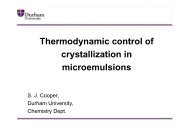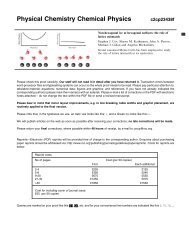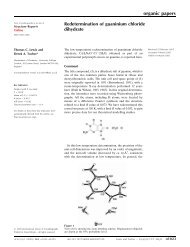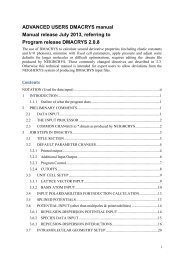An Introduction to the Theory of Crystalline Elemental Solids and ...
An Introduction to the Theory of Crystalline Elemental Solids and ...
An Introduction to the Theory of Crystalline Elemental Solids and ...
You also want an ePaper? Increase the reach of your titles
YUMPU automatically turns print PDFs into web optimized ePapers that Google loves.
18<br />
FIG. 6: Illustration <strong>of</strong> <strong>the</strong> formation <strong>of</strong> sp 3 valence <strong>and</strong> conduction b<strong>and</strong>s in <strong>the</strong> tetrahedral<br />
semiconduc<strong>to</strong>rs. As one goes from C <strong>to</strong> Si <strong>to</strong> Ge <strong>to</strong> Sn <strong>the</strong> size <strong>of</strong> <strong>the</strong> a<strong>to</strong>ms increase, which<br />
increases <strong>the</strong> b<strong>and</strong> widths <strong>and</strong> decreases <strong>the</strong> b<strong>and</strong> gap (E gap ).<br />
an optimum packing fraction but instead result from optimal orbital overlap <strong>and</strong> bonding<br />
between <strong>the</strong> partners. Often this leads covalent solids <strong>to</strong> adopt tetrahedral structures<br />
such as <strong>the</strong> diamond <strong>and</strong> zincblende structures; with <strong>the</strong> classic examples <strong>of</strong> such solids<br />
being <strong>the</strong> tetrahedral group IV elements (C, Si, Ge, <strong>and</strong> α-Sn). A useful concept for<br />
underst<strong>and</strong>ing such structures <strong>and</strong> indeed covalent materials in general is what is known<br />
as hybridization, which we now briefly discuss.<br />
Hybridization or hybrid orbital formation has proved <strong>to</strong> be an extremely helpful <strong>and</strong> instructive<br />
concept for underst<strong>and</strong>ing <strong>the</strong> structure <strong>and</strong> bonding in many covalent materials<br />
(solids <strong>and</strong> molecules). Here we introduce <strong>the</strong> basic ideas <strong>of</strong> hybrid orbital formation with<br />
<strong>the</strong> single illustrative example <strong>of</strong> <strong>the</strong> group IV elements, C, Si, Ge, <strong>and</strong> Sn. All four elements<br />
have four valence orbitals with <strong>the</strong> valence configuration ns 2 , np 2 (A in Fig. 6).<br />
One finds that it is possible <strong>to</strong> make linear combinations <strong>of</strong> <strong>the</strong>se four valence orbitals<br />
<strong>to</strong> yield a new set <strong>of</strong> hybrid orbitals. The particular set <strong>of</strong> hybrid orbitals relevant <strong>to</strong><br />
<strong>the</strong> present discussion are <strong>the</strong> sp 3 -hybrid functions. These four sp 3 hybrid orbitals can be<br />
written down as<br />
φ 1 = 1 2 (s + p x + p y + p z ) (28)<br />
φ 2 = 1 2 (s + p x − p y − p z ) (29)<br />
φ 3 = 1 2 (s − p x + p y − p z ) (30)<br />
φ 4 = 1 2 (s − p x − p y + p z ) (31)<br />
yielding orbitals which point <strong>to</strong> <strong>the</strong> four corners <strong>of</strong> a tetrahedron (B in Fig. 6). This set<br />
<strong>of</strong> hybrid orbitals corresponds <strong>to</strong> <strong>the</strong> orbitals <strong>of</strong> an excited state <strong>of</strong> <strong>the</strong> a<strong>to</strong>m, i.e., this<br />
set <strong>of</strong> hybrid orbitals is less stable than <strong>the</strong> original set <strong>of</strong> a<strong>to</strong>mic orbitals, by an amount<br />
known as <strong>the</strong> hybridization energy. In certain circumstances, however, it is possible for<br />
hybrid orbitals on adjacent a<strong>to</strong>ms <strong>to</strong> bond more effectively with each o<strong>the</strong>r than <strong>the</strong><br />
a<strong>to</strong>mic orbitals would have done <strong>and</strong> in so-doing render <strong>the</strong> composite (molecule, solid)







